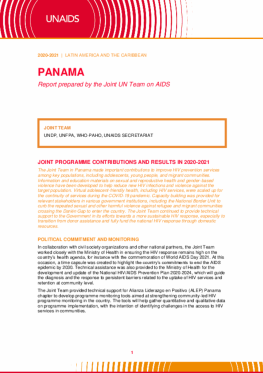The Joint Team in Panama made important contributions to improve HIV prevention services among key populations, including adolescents, young people, and migrant communities. Information and education materials on sexual and reproductive health and gender-based violence have been developed to help reduce new HIV infections and violence against the target population. Virtual adolescent-friendly health, including HIV services, were scaled up for the continuity of services during the COVID-19 pandemic. Capacity building was provided for relevant stakeholders in various government institutions, including the National Border Unit to curb the repeated sexual and other harmful violence against refugee and migrant communities crossing the Darién Gap to enter the country. The Joint Team continued to provide technical support to the Government in its efforts towards a more sustainable HIV response, especially to transition from donor assistance and fully fund the national HIV response through domestic resources.
Political commitment and monitoring
In collaboration with civil society organizations and other national partners, the Joint Team worked closely with the Ministry of Health in ensuring the HIV response remains high on the country’s health agenda, for instance with the commemoration of World AIDS Day 2021. At this occasion, a time capsule was created to highlight the country’s commitments to end the AIDS epidemic by 2030. Technical assistance was also provided to the Ministry of Health for the development and update of the National HIV/AIDS Prevention Plan 2020-2024, which will guide the diagnosis and the response to persistent barriers related to the uptake of HIV services and retention at community level.
The Joint Team provided technical support for Alianza Liderazgo en Positivo (ALEP) Panama chapter to develop programme monitoring tools aimed at strengthening community-led HIV programme monitoring in the country. The tools will help gather quantitative and qualitative data on programme implementation, with the intention of identifying challenges in the access to HIV services in communities.
HIV prevention among young people and key populations
A peer educators' manual and a backpack containing booklets with information on sexual and reproductive health (SRH), prevention of gender-based violence (GBV) and smoking prevention were developed to aid sensitization of adolescent and young people—smoking is a major public health challenge and national priority in Panama, especially among the youth population. Informative flipchart materials were also developed for adolescents and migrants to disseminate information on HIV prevention and further reduce HIV infections within these groups.
To improve accessibility of Adolescent-Friendly Health Services (SSAA) during the COVID-19 pandemic, the Joint Team developed virtual programmes targeting adolescent and young people in several municipalities across the country. Eleven virtual workshops on various topics including healthy eating, entrepreneurship, cooking, and home gardening, were held in 2021 for adolescents from 12 to 18 years old.
In 2021, around 140 000 migrant people entered Panama through the Isthmus strip, far more than the number of people that came in the country in the last eight years. The number of migrants from Venezuela has also increased exponentially in recent years due to various reasons, including the effects of COVID-19 on the economy in the refugees’ countries of origin. There have been repeated warnings of the violence encountering refugees and migrants crossing the Darién Gap, including sexual and general violence, which increase their risk of HIV infection. In response, the Joint Team supported several initiatives in Darien to ensure the protection of the migrant population, including people with HIV and people from the lesbian, gay, bisexual, transgender, and intersex (LGBTI) community. These efforts included training of 250 officials from the Ombudsman's Office of Panama and Humanitarian Border Security Unit (CENAFRONT) of the National Border Unit to improve their understanding and capacity for the protection of people with HIV and people from the LGBTI+ community during their mobility and when settled in humanitarian settings; officials from the Ministry of Health were also trained on the post-exposure prophylaxis (PEP) kit used to reduce HIV risk related to sexual violence cases among migrant people; and PEP kits and antiretroviral treatments (ART) were mobilized and delivered to eligible migrant who survived violence. A Regional Platform for Interagency Coordination was also established to ensure coherence and consistency while accelerating efforts targeting migrant population efforts in 17 countries in Latin America and the Caribbean, with a particular focus on achieving coherence and consistency in migration response.


